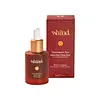What's inside
What's inside
 Key Ingredients
Key Ingredients

 Benefits
Benefits

 Concerns
Concerns

 Ingredients Side-by-side
Ingredients Side-by-side

Water
Skin ConditioningGlycerin
HumectantCaramel
Cosmetic ColorantErythrulose
TanningPrunus Armeniaca Juice
MoisturisingHydroxyethyl Acrylate/Sodium Acryloyldimethyl Taurate Copolymer
Emulsion StabilisingOpuntia Ficus-Indica Stem Extract
Skin ConditioningPhenoxyethanol
PreservativeCalendula Officinalis Extract
Skin ConditioningPolyacrylate Crosspolymer-6
Emulsion StabilisingCitric Acid
BufferingSodium Gluconate
Skin ConditioningChamomilla Recutita Extract
Skin ConditioningMalva Sylvestris Flower Extract
Skin ConditioningParfum
MaskingEthylhexylglycerin
Skin Conditioning1,2-Hexanediol
Skin ConditioningPotassium Sorbate
PreservativeSodium Hyaluronate
HumectantBenzyl Benzoate
AntimicrobialBenzyl Cinnamate
PerfumingWater, Glycerin, Caramel, Erythrulose, Prunus Armeniaca Juice, Hydroxyethyl Acrylate/Sodium Acryloyldimethyl Taurate Copolymer, Opuntia Ficus-Indica Stem Extract, Phenoxyethanol, Calendula Officinalis Extract, Polyacrylate Crosspolymer-6, Citric Acid, Sodium Gluconate, Chamomilla Recutita Extract, Malva Sylvestris Flower Extract, Parfum, Ethylhexylglycerin, 1,2-Hexanediol, Potassium Sorbate, Sodium Hyaluronate, Benzyl Benzoate, Benzyl Cinnamate
Water
Skin ConditioningDihydroxyacetone
Skin ConditioningAlcohol Denat.
AntimicrobialGlycerin
HumectantErythrulose
TanningRubus Idaeus Seed Oil
EmollientAloe Barbadensis Leaf Juice
Skin ConditioningCaramel
Cosmetic ColorantTocopheryl Acetate
AntioxidantXanthan Gum
EmulsifyingPolysorbate 80
EmulsifyingParfum
MaskingLimonene
PerfumingGeraniol
PerfumingHexyl Cinnamal
PerfumingBenzyl Salicylate
PerfumingSodium Hydroxide
BufferingBenzoic Acid
MaskingDehydroacetic Acid
PreservativePhenoxyethanol
PreservativeWater, Dihydroxyacetone, Alcohol Denat., Glycerin, Erythrulose, Rubus Idaeus Seed Oil, Aloe Barbadensis Leaf Juice, Caramel, Tocopheryl Acetate, Xanthan Gum, Polysorbate 80, Parfum, Limonene, Geraniol, Hexyl Cinnamal, Benzyl Salicylate, Sodium Hydroxide, Benzoic Acid, Dehydroacetic Acid, Phenoxyethanol
Ingredients Explained
These ingredients are found in both products.
Ingredients higher up in an ingredient list are typically present in a larger amount.
We don't have a description for Caramel yet.
We don't have a description for Erythrulose yet.
Glycerin is already naturally found in your skin. It helps moisturize and protect your skin.
A study from 2016 found glycerin to be more effective as a humectant than AHAs and hyaluronic acid.
As a humectant, it helps the skin stay hydrated by pulling moisture to your skin. The low molecular weight of glycerin allows it to pull moisture into the deeper layers of your skin.
Hydrated skin improves your skin barrier; Your skin barrier helps protect against irritants and bacteria.
Glycerin has also been found to have antimicrobial and antiviral properties. Due to these properties, glycerin is often used in wound and burn treatments.
In cosmetics, glycerin is usually derived from plants such as soybean or palm. However, it can also be sourced from animals, such as tallow or animal fat.
This ingredient is organic, colorless, odorless, and non-toxic.
Glycerin is the name for this ingredient in American English. British English uses Glycerol/Glycerine.
Learn more about GlycerinParfum is a catch-all term for an ingredient or more that is used to give a scent to products.
Also called "fragrance", this ingredient can be a blend of hundreds of chemicals or plant oils. This means every product with "fragrance" or "parfum" in the ingredients list is a different mixture.
For instance, Habanolide is a proprietary trade name for a specific aroma chemical. When used as a fragrance ingredient in cosmetics, most aroma chemicals fall under the broad labeling category of “FRAGRANCE” or “PARFUM” according to EU and US regulations.
The term 'parfum' or 'fragrance' is not regulated in many countries. In many cases, it is up to the brand to define this term.
For instance, many brands choose to label themselves as "fragrance-free" because they are not using synthetic fragrances. However, their products may still contain ingredients such as essential oils that are considered a fragrance by INCI standards.
One example is Calendula flower extract. Calendula is an essential oil that still imparts a scent or 'fragrance'.
Depending on the blend, the ingredients in the mixture can cause allergies and sensitivities on the skin. Some ingredients that are known EU allergens include linalool and citronellol.
Parfum can also be used to mask or cover an unpleasant scent.
The bottom line is: not all fragrances/parfum/ingredients are created equally. If you are worried about fragrances, we recommend taking a closer look at an ingredient. And of course, we always recommend speaking with a professional.
Learn more about ParfumPhenoxyethanol is a preservative that has germicide, antimicrobial, and aromatic properties. Studies show that phenoxyethanol can prevent microbial growth. By itself, it has a scent that is similar to that of a rose.
It's often used in formulations along with Caprylyl Glycol to preserve the shelf life of products.
Water. It's the most common cosmetic ingredient of all. You'll usually see it at the top of ingredient lists, meaning that it makes up the largest part of the product.
So why is it so popular? Water most often acts as a solvent - this means that it helps dissolve other ingredients into the formulation.
You'll also recognize water as that liquid we all need to stay alive. If you see this, drink a glass of water. Stay hydrated!
Learn more about Water